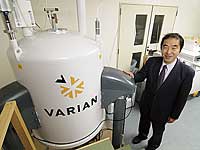"Global warming is a huge issue, but we also need to recognize the threat posed by resource depletion. For energy policy to be meaningful, it needs to address both of those issues. That will mean," says Tokyo Tech's Shuichiro Hirai (right, pointing toward the Tokyo skyline), "accompanying scientific research with efforts to engage the community at large in energy-related initiatives."
Headlines have been announcing for decades that we'll run out of oil in 30 years," Hirai observes. "Thirty years has been sort of a continuous horizon, receding continuously as we have discovered new reserves, as technology has increased yields from known reserves, and as estimates have simply proved wrong. But we have reached the point where the end of oil really is becoming a perceptible eventuality.
"The end of natural gas is also becoming a tangible reality," continues Hirai, "just a few years further into the future. Even the finitude of the world's massive coal reserves is increasingly upon us. And let us bear in mind that our coal consumption will accelerate as we exhaust our reserves of other fossil fuels."
Hirai is a professor in Tokyo Tech's Research Center for Carbon Recycling and Energy. And he heads the university's newly established Multidisciplinary Education and Research Center for Energy Science. That center is one of 11 education-and-research group-ings at Tokyo Tech that receive special government funding as centers of excellence. It tackles energy-related issues from the dual perspectives of (1) forestalling global warming and (2) securing sufficient supplies of energy to ensure the survival and prosperity of humankind.
New kinds of interdisciplinary interaction
Tokyo Tech continues to mobilize its impressive resources in accordance with a clearly defined priority: deploy a comprehensive, interdisciplinary range of capabilities to conceive and propose feasible solutions for issues of pressing concern for society. Sustainability in securing and using energy resources is a compelling issue for the scientific community. And the university's Multidisciplinary Education and Research Center for Energy Science focuses a characteristically broad spectrum of Tokyo Tech capabilities on identifying ways of ensuring that sustainability.
The center spans 14 departments in mechanical engineering, electrical and electronic engineering, chemistry, materials science, and the social sciences. Hirai is especially emphatic about the role of the social sciences in the center's multidisciplinary approach. "Awareness of social context is absolutely essential to our work in fostering human resources to resolve the world's energy-related issues. The scope of our center gives us the chance to foster synergies through new kinds of interdisciplinary interaction."
Hirai's own research portfolio, replete with award-winning papers, epitomizes the broad-ranging perspective that he espouses. It includes pioneering work in applying magnetic resonance imaging (MRI) to monitoring the electrolytic efficiency of fuel cells in operation. Hirai has led initiatives, meanwhile, for demonstrating the viability of capturing carbon dioxide and sequestering it in the earth and in the ocean. His research activity even encompasses simulation studies on particulate filters for making fuel-saving diesel technology cleaner.
A one-of-its-kind MRI installation is a highlight of the research facilities at Tokyo Tech's Multidisciplinary Education and Research Center. Water distribution in electrolytic membranes is a determinant of performance in polymer electrolyte membrane fuel cells. Hirai and his colleagues, using their MRI system, have succeeded in monitoring that distribution while fuel cells are operating. Their analytical approach could support important gains in fuel cell performance.

"The world is running out of fossil fuels—probably not in my lifetime, but very possibly during the lifetimes of my children. We've got to act now to ensure viable supplies of energy for future generations."

Hirai's research group has used MRI to depict the displacement of water by carbon dioxide injected into a porous medium. The simulation took place under conditions comparable to a depth of 800 meters, the porous medium was Berea sandstone with a pore volume of 1.5 milliliters, and the injection rate was 0.05 milliliters per minute. Sequestering carbon dioxide in the earth or in the ocean could help prevent global.

Hirai poses beside his center's MRI system. Creative research with that system has supported breakthroughs in analyzing fuel cell performance, and members of the center have also used the system for simulations of carbon dioxide capture and sequestration and other energy-related research.
. Any information published on this site will be valid in relation to Science Tokyo.





